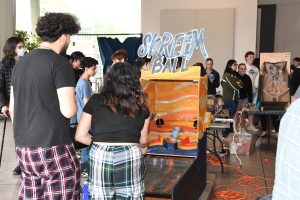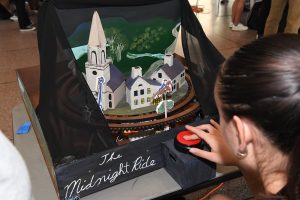
How would you design a game based on a painting by American artist Jackson Pollock, known for his wild splatters and drip technique? For mechanical engineering first-year student Jason Ahn and his Mechanical Engineering Freshman Design Exhibition teammates, the answer was right in front of them.
“It’s pretty similar to his style,” Ahn said of the team’s game that involved throwing balls through colored sections of a Pollock painting before the timer ran out. “He just kind of throws paint at a canvas.”
 Most days, the Baltimore Museum of Art is the best place to view the works of famous painters like Pollock. The Homewood campus gave it some competition April 18, though, as the Glass Pavilion showcased 20 such painters—in the form of interactive arcade games.
Most days, the Baltimore Museum of Art is the best place to view the works of famous painters like Pollock. The Homewood campus gave it some competition April 18, though, as the Glass Pavilion showcased 20 such painters—in the form of interactive arcade games.
Featuring games like Banjo Hero, inspired by Henry Ossawa Tanner, and Skreem-Ball, inspired by Edvard Munch, the event showcased the more creative and interpretive side of mechanical engineering.
 “One of the main goals of this project was to have the students think about what they’re doing from the outsider’s perspective; to think about a customer, a user, not just themselves,” said Steven Marra, associate teaching professor in mechanical engineering and lead instructor for the lab. “They did a great job.”
“One of the main goals of this project was to have the students think about what they’re doing from the outsider’s perspective; to think about a customer, a user, not just themselves,” said Steven Marra, associate teaching professor in mechanical engineering and lead instructor for the lab. “They did a great job.”
While painters like Leonardo da Vinci and Pablo Picasso were represented by their better-known works, some teams took a more obscure tack, as in the case of Edward Hopper’s 1940 painting “Gas” and Grant Wood’s 1936 painting “The Midnight Ride of Paul Revere.” In the latter game, the player guides Revere astride his horse on a circular track, dodging obstacles on the way to gather the colonial militia.

“We didn’t go for the classic one, ‘American Gothic’,” said Wood team member Erin Ventrudo. “We thought this one was more fun.”
Some teams opted for a more conceptual approach, like the Rembrandt team, who focused on the artist’s famed use of light and shadow. In their game, the player aims a beam at pop-up characters from “The Night Watch”—under cover of a hooded darkroom.
“Across all of his paintings he used very high contrast with a lot of dark colors and a little bit of light colors, and in quite unusual places,” said team member Linda Boieriu. “So we wanted to incorporate that into the game.”